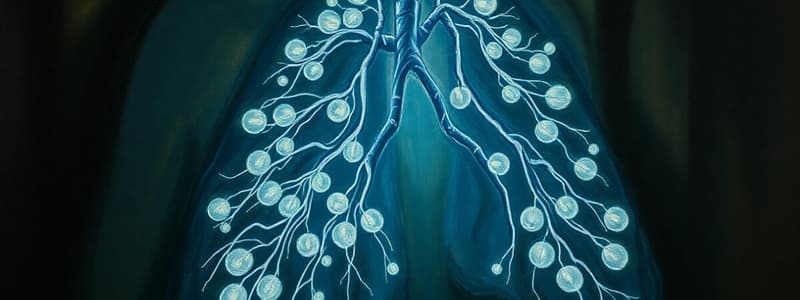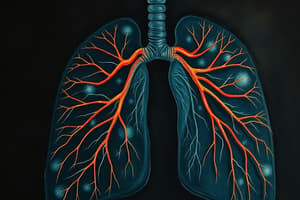Podcast
Questions and Answers
Which of the following factors directly increases the formation of 2,3-bisphosphoglycerate (BPG) in red blood cells?
Which of the following factors directly increases the formation of 2,3-bisphosphoglycerate (BPG) in red blood cells?
- Increased pH
- Certain hormones, such as thyroxine, growth hormone, epinephrine, norepinephrine, and testosterone (correct)
- Decreased temperature
- Increased carbon dioxide levels
What is the primary means by which carbon dioxide is transported in the blood?
What is the primary means by which carbon dioxide is transported in the blood?
- Directly attached to red blood cell membranes
- Dissolved in blood plasma
- Bound to hemoglobin as carbamino compounds
- Converted to bicarbonate ions (HCO3-) (correct)
Which of the following conditions would likely result in a leftward shift of the oxygen-hemoglobin dissociation curve?
Which of the following conditions would likely result in a leftward shift of the oxygen-hemoglobin dissociation curve?
- Increased temperature
- Decreased pH (acidosis)
- Decreased carbon dioxide levels (correct)
- Increased 2,3-bisphosphoglycerate (BPG) levels
During hypothermia, which of the following is most likely to occur?
During hypothermia, which of the following is most likely to occur?
What is the primary mechanism by which the Bohr effect influences oxygen-hemoglobin binding?
What is the primary mechanism by which the Bohr effect influences oxygen-hemoglobin binding?
Which of the following is a consequence of the rightward shift in the oxygen-hemoglobin dissociation curve?
Which of the following is a consequence of the rightward shift in the oxygen-hemoglobin dissociation curve?
How does carbon dioxide contribute to the release of oxygen from hemoglobin?
How does carbon dioxide contribute to the release of oxygen from hemoglobin?
Which of the following conditions will not lead to a rightward shift in the oxygen-hemoglobin dissociation curve?
Which of the following conditions will not lead to a rightward shift in the oxygen-hemoglobin dissociation curve?
What is the relationship between hemoglobin saturation and the partial pressure of oxygen (PO2)?
What is the relationship between hemoglobin saturation and the partial pressure of oxygen (PO2)?
What is the Bohr effect?
What is the Bohr effect?
What is the primary factor that determines the amount of oxygen bound to hemoglobin?
What is the primary factor that determines the amount of oxygen bound to hemoglobin?
What is the significance of the 2,3-bisphosphoglycerate (2,3-BPG) molecule in oxygen transport?
What is the significance of the 2,3-bisphosphoglycerate (2,3-BPG) molecule in oxygen transport?
Which of the following terms refers to the exchange of gases between the alveoli of the lungs and the blood in the pulmonary capillaries?
Which of the following terms refers to the exchange of gases between the alveoli of the lungs and the blood in the pulmonary capillaries?
How does the partial pressure of carbon dioxide (PCO2) affect the affinity of hemoglobin for oxygen?
How does the partial pressure of carbon dioxide (PCO2) affect the affinity of hemoglobin for oxygen?
What percentage of the total oxygen transported in the blood is dissolved in plasma?
What percentage of the total oxygen transported in the blood is dissolved in plasma?
Which of the following processes describes the exchange of gases between the blood in the systemic capillaries and the tissue cells?
Which of the following processes describes the exchange of gases between the blood in the systemic capillaries and the tissue cells?
Flashcards
Bohr Effect
Bohr Effect
The influence of CO2 and pH on hemoglobin oxygen release.
Rightward Shift
Rightward Shift
Occurs when Hb releases O2 more readily due to increased PCO2 or decreased pH.
Leftward Shift
Leftward Shift
Occurs when Hb holds onto O2 more tightly due to decreased PCO2 or increased pH.
Role of Temperature
Role of Temperature
Signup and view all the flashcards
2,3-BPG Function
2,3-BPG Function
Signup and view all the flashcards
Carbon Dioxide Transport
Carbon Dioxide Transport
Signup and view all the flashcards
Dissociation Curve
Dissociation Curve
Signup and view all the flashcards
Hypoxia Effect
Hypoxia Effect
Signup and view all the flashcards
External Respiration
External Respiration
Signup and view all the flashcards
Internal Respiration
Internal Respiration
Signup and view all the flashcards
Oxygen Transport
Oxygen Transport
Signup and view all the flashcards
Hemoglobin Saturation
Hemoglobin Saturation
Signup and view all the flashcards
Oxygen-Hemoglobin Dissociation Curve
Oxygen-Hemoglobin Dissociation Curve
Signup and view all the flashcards
Factors Affecting Hemoglobin Affinity
Factors Affecting Hemoglobin Affinity
Signup and view all the flashcards
2,3-Bisphosphoglycerate (2,3-BPG)
2,3-Bisphosphoglycerate (2,3-BPG)
Signup and view all the flashcards
Study Notes
Gas Exchange and Transport
- External and Internal Respiration:
- External respiration is pulmonary gas exchange. O2 diffuses from the alveoli to blood in the pulmonary capillaries, and CO2 diffuses in the opposite direction. This converts deoxygenated blood to oxygenated blood, returning to the left side of the heart.
- Internal respiration is systemic gas exchange, exchanging O2 and CO2 between systemic capillaries and tissue cells. Oxygenated blood becomes deoxygenated as O2 is released, and internal respiration occurs throughout the body.
Oxygen Transport
-
Oxygen's Solubility: Oxygen does not dissolve easily in water. Only 1.5% of inhaled oxygen is dissolved in blood plasma; the remaining 98.5% is bound to hemoglobin in red blood cells.
-
Hemoglobin and Oxygen Binding: Oxygen and hemoglobin bind in a reversible reaction to form oxyhemoglobin. This binding is easily reversible.
Relationship Between Hemoglobin and Oxygen Partial Pressure
- PO2 and Saturation: PO2 (partial pressure of oxygen) is the most important factor determining how much O2 binds to hemoglobin. Fully saturated hemoglobin is converted from reduced hemoglobin (Hb) to oxyhemoglobin (Hb-O2). Partially saturated hemoglobin is a mixture of Hb and Hb-O2.
- Oxygen-Hemoglobin Dissociation Curve: The curve illustrates the relationship between percent saturation of hemoglobin and PO2 at normal body temperature.
Other Factors Affecting Hemoglobin Affinity for Oxygen
- Acidity (pH): Lower pH (increased acidity) decreases hemoglobin's affinity for O2, causing more O2 to be released. This is known as the Bohr effect. Higher pH (alkalosis) has the opposite effect.
- Partial Pressure of Carbon Dioxide (PCO2): An increase in PCO2 also decreases hemoglobin's affinity for O2, facilitating oxygen unloading. Lower PCO2 leads to a leftward shift.
- Temperature: Increased temperature decreases hemoglobin's affinity for O2, causing more O2 to be unloaded. Higher temperatures increase the release of oxygen.
2,3-Bisphosphoglycerate (BPG)
- Effect on Oxygen Affinity: BPG is a substance in red blood cells that decreases hemoglobin's affinity for oxygen, promoting its unloading.
- Formation in Red Blood Cells: BPG is produced during glycolysis in red blood cells. Certain hormones (like thyroxine) increase BPG levels.
Carbon Dioxide Transport
-
Dissolved CO2: A small amount (7%) of CO2 is dissolved in blood plasma, diffusing into alveolar air upon reaching the lungs for excretion.
-
Carbamino Compounds: About 23% of CO2 combines with amino acids and proteins in blood forming carbamino compounds.
-
Bicarbonate Ions: Approximately 70% of CO2 is transported as bicarbonate ions (HCO3⁻) in blood plasma. This is part of a process where CO2 reacts with water to produce carbonic acid, which dissociates into hydrogen ions and bicarbonate ions.
Studying That Suits You
Use AI to generate personalized quizzes and flashcards to suit your learning preferences.




